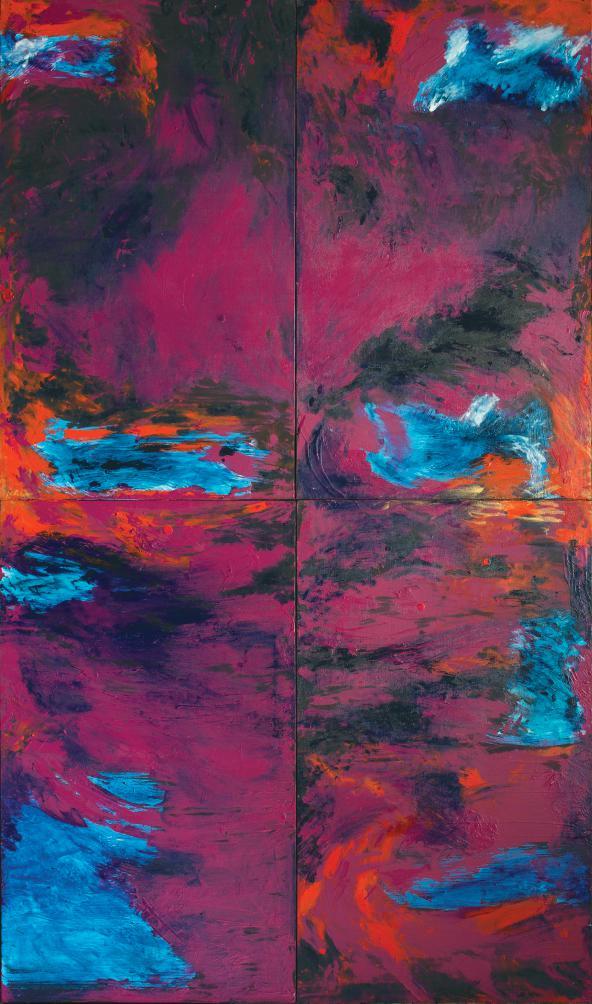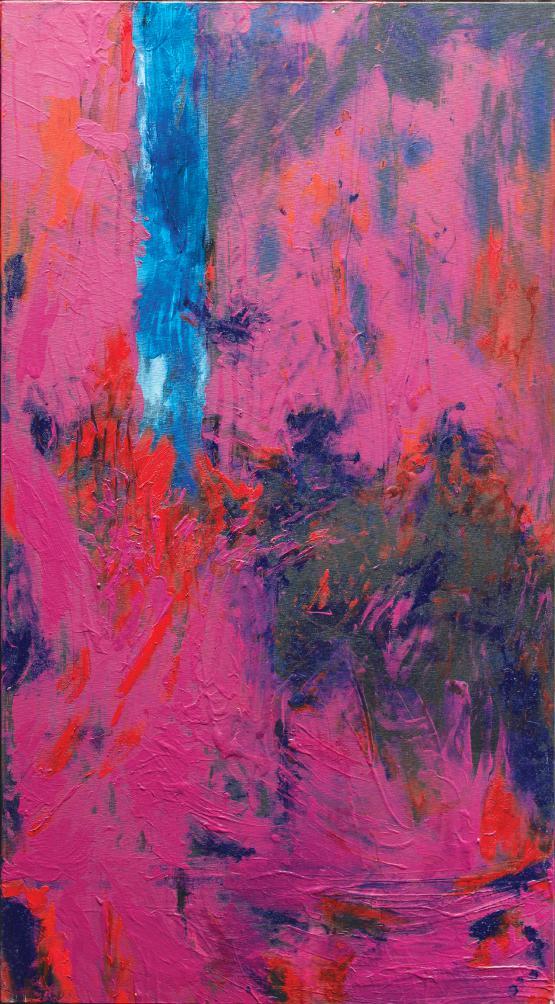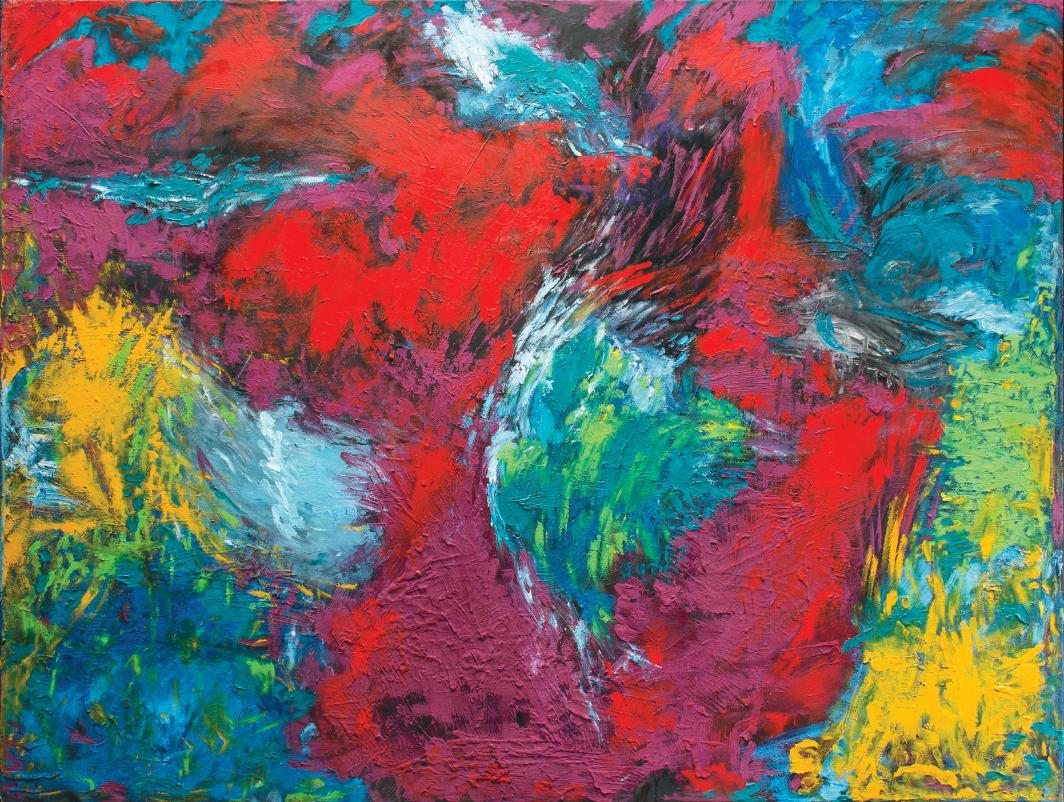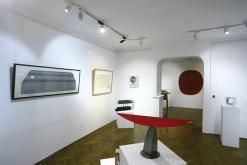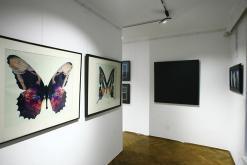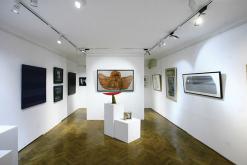GALERIJA LUCIDA
IZDAVAČ: GALERIJA LUCIDA
ZA IZDAVAČA: ZLATOMIR RADIVOJEVIĆ, DIREKTOR
SAVET GALERIJE:
MILOVAN DAGOVIĆ
DRAGOSLAV KRNAJSKI I
IVONA FREGL
KUSTOS IZLOŽBE: IVONA FREGL
TEKST I PREVOD: IVONA FREGL
FOTOGRAFIJA: ŠAROVIĆ SRĐAN
DIZAJN PRELOM: MARTA KLAR
ŠTAMPA: PUBLIKUM
TIRAŽ: 250
Izložbu podržalo Ministarstvo kulture i informisanje Republike Srbije
Republika Srbija

MINISTARSTVO KULTURE I INFORMISANJA
CIP - Каталогизација у публикацији Библиотека Матице српске, Нови Сад 75.071.1:929 Vučinić Lj.(083.824)
ВУЧИНИЋ, Љубомир, 1956-
Ljubomir Vučinić : jazz baroque : Galerija Lucida, Beograd, 1. 06. - 15. 06. 2017 / [tekst i prevod Ivona Fregl ; fotografije Šarović Srđan]. - Beograd : Galerija Lucida, 2017 (Beograd : Publikum). - 20 str. : ilustr. ; 20 cm
Uporedo srp. tekst i engl. prevod. - Tiraž 250.
ISBN 978-86-80222-07-3
a) Вучинић, Љубомир (1956-) - Сликарство - Изложбени каталози COBISS.SR-ID 314632199
Ljubomir Vu č ini ć , umetnik koji u svom radu neprekidno istražuje različite medije (crtež, slikarstvo, instalacije), postavlja pred svoju kreativnost sve veće izazove oprobavajući vizuelni izraz kroz različite umetničke stilove (apstraktni koloristički ekspresionizam, geometrijsku apstrakciju). Njegovo trenutno umetničko interesovanje kreće se u pravcu istraživanja “vizuelne muzike”, dela relativno nove teoretske oblasti vizuelne kulture. Ljubomir Vučinić veruje u javni angažman umetnosti i često izlaže svoje radove: “Kada uđem u prazan prostor, ja ga preoblikujem, konfigurišem, dam mu obeležje koje jeste lično, ali treba da se iščita i iz nečijeg drugog ugla, na nov način, a da sve to korespondira sa vremenom i prostorom u kome živimo”.
Izložba u galeriji Lucida peta je izložba u poslednje dve godine na kojoj umetnik predstavlja slike iz svog najnovijeg ciklusa koji se oslanja na atmosferu ispunjenosti prostora džez muzikom i na neke od principa baroknog slikarstva. Tokom dve od prethodnih izložbi, muzičari
Atila Dora, Saterlend, Tijana Stanković i voko-vizuelna umetnica Mari Falčik izveli su performanse inspirisane Vučinićevom vizuelnom muzikom. Polazište ovog ciklusa slika su umetnikovi apstraktni crteži u boji, nastali osamdesetih godina XX veka. Budući da je zaposlen kao profesor crtanja na novosadskoj Likovnoj akademiji, ne iznenađuje činjenica da Vučinić smatra da od crteža sve kreće: “Crtež je fundamentalna disciplina. Slike velikog, reprezentativnog formata nastaju iz mog malog dodira sa hartijom, iz malog zapisa, iz nečeg što nema velikih pretenzija, pa se ti neopterećeni mali fluidi postepeno kondenzuju, pretvaraju u nešto što treba da bude veće, reprezentativno, što slika i treba da bude”.
U okviru izložbe pod nazivom Jazz Baroque u galeriji
Lucida, Vučinić pred publiku izlaže šest ulja na platnu velikih dimenzija, rađenih u stilu apstraktnog ekspresionizma. Nosilac svih kompozicija je boja - uskovitlane mase plave i crvene, crne, žute, ljubičaste, narandžaste i zelene prepliću se na Vučinićevim platnima. Slikar Macdonald-Wright primetio je da „što se više odmiče od oka, prizor postaje sve više plavo-ljubičast ili ljubičast dok, kad napreduje ka oku, njegove boje postaju sve toplije, više žute i narandžaste”. Vučinić za svoje slike
kaže da su “zgusnule tamno plavu boju koja prelazi u crno-ljubičastu, a onda izviru crveni akcenti. To je moja likovna priča”. Na slikama bojene površine prestižu jedna drugu, boreći se za preimućstvo na platnu. Tekstura platna koja se probija ispod pastuoznih namaza boje i vidljivi široki potezi slikarske četke teže da ukrote energetsku erupciju boja, pokušavajući da ih vežu za dvodimenzionalnu površinu slike. Ipak, ovim bojenim entitetima prostor slike je tesan - crna se survava u ponor zadnjeg plana, crvena izleće u prednji plan kao da želi da zauzme i prostor oko posmatrača. Vučinić istražuje prostor i njegovo širenje i skupljanje (pulsiranje) u vremenu (“ako moja um dela uopšte imaju motiv, onda je to prostor”); slike iz ovog ciklusa mogu se posmatrati zasebno, kao pojedinačni, samostalni segmenti osmišljenih prostornih odnosa, ali i spojene u diptihe, triptihe i poliptihe, kada dočaravajući iluziju beskonačne prostorne simfonije kovitlaca različitih energija.
Na tekovinama apstraktnog ekspresionizma
Zašto je Vučinić odabrao nasleđe apstraktnog ekspresionizma za polaznu tačku svog najnovijeg ciklusa slika? Figuralno u umetnosti uglavnom se povezuje sa realnim, telesnim i tradicijom mimezisa, dok apstraktno označava slobodu izražavanja, eksperimentisanje, duhovnost, nezavisnost, otvorenost uma i same umetnosti. “Izgleda da umetnici više vole apstrakciju od figuracije jer im apstrakcija daje veću slobodu da izraze svoj mentalni svet i spiritualnost u okviru svog rada”, primetio je William Moritz, istoričar filma i ekspert za oblast vizuelne muzike. Odbacivanje figuralnih prikaza imalo je kroz istoriju spiritualnu, ideološku i estetsku konotaciju; Vučinić koristi apstrakciju kao oblik duhovnog izraza da bi pomerio fokus sa tela na duh, sa materijalnog na spiritualni svet.
Mnogi slikari novijih generacija i dalje stvaraju apstraktno-ekspresionističke radove bazirane na iskustvu umetnika koji su ovaj stil stvorili i prokrčili put, pritom ih ne imitirajući. Savremena američka umetnica Michelle Meister stvara apstraktne ekspresionističke slike na kojma preovlađuju plave i crvene nijanse, te su koloristički vrlo slične Vučinićevim novim slikama, ali njene kompozicije karakterišu mnogo mirnija, jednostavnija rešenja.
George Hofmann smatra da “apstraktni ekspresionizam nije umro, kao što mnogi misle – on se povukao, ili tačnije rečeno, ugušila ga je površnost: preobilje ispraznih i beznačajnih pokreta na platnu zaglibili su umetničku svest svog vremena, kao rezultat nepotpunog razumevanja, površnih interpretacija i nedostatka osećanja: banalno je preteklo istinito, duboko i izvorno”. Ljubomir Vučinić na sličan način govori o situaciji u današnjem svetu i umetnosti: “Popularno je u potpunosti potisnulo pametno”.
Jazz Baroque... BAROK?
Naslov izložbe je Jazz Baroque, pa da krenemo od drugog, vizuelnog dela ove zbunjujuće kovanice – šta je to barokno u slikama Ljubomira Vučinića? Barokni uticaj može se videti u dva segmenta Vučinićevog slikarstva:
1) u formalnom, koji se ogleda u bogatom, zasićenom koloritu i dramatičnim kompozicionim rešenjima, i
2) u samom pristupu promišljanju umetnosti – barok je nastao kao odgovor na manirizam, umetnost elite, za čije je shvatanje bilo potrebno mnogo predznanja i učenosti; manirizam je bio umetnost male grupe bogatih intelektualaca – mecena, koji su bili naručioci ove vrste umetnosti, te su samo oni i njihova obrazovana okolina mogli da ga razumeju. Barokna umetnost jednim delom nastaje kao reakcija na ovakav elitistički pristup umetnosti. Svojim grandioznim formama, snažnom gestikulacijom, dramatičnom korporalnom retorikom, pâtosom i emotivnim nabojem, barokna dela bila su “čitljiva” i običnom, pučkom čoveku kome su bila namenjena, sada pozicionirana u naosima velelepnih katedrala i drugim javnim prostorima, a ne više skrivena po privatnim odajama i salonima. Paralela se može povući između Manirizma sa jedne i umetnosti Moderne i Postmoderne sa druge strane, za čije je dublje razumevanje takođe potrebna prethodna edukacija i poznavanje materije.
Ljubomir Vučinić vraća umetnost običnim ljudima, govoreći likovnim jezikom emocija koji svako može da razume, ne oduzimajući pritom umetnosti njenu kontemplativnu komponentu. Sličan osećaj se javlja i pri slušanju džez muzike.
Kao i Vasilij Kandinsky koji u svom poznatom eseju O duhovnom u umetnosti, objašnjava “zvučnost boja”, (odnosno određenim instrumentima pripisuje odgovarajuće boje: žuta - zvuk trube, crvena - doboš, plavaviolončelo, kontrabas ili orgulje), Vučinić čvrsto veruje da se iz formalno apstraktne strukture muzike može razviti nova vizuelna umetnost.
Od poslednjih decenija XIX i početka XX veka, muzika igra izuzetno važnu ulogu u stilskom razvoju vizuelnih umetnosti. Kao inspiracija umetnicima koji su želeli da stvore čistu i transcedentalnu umetničku formu, muzika je uticala na eksperimentisanje sa nekonvencionalnim tehnikama u pristupu stvaranju umetničkog dela.
Clement Greenberg kaže da, od svih umetnosti, muzika “ima najmanje veze sa nečim izvan sebe same” i samim tim predstavlja “najčistiji medij”.
Sve vrste muzike (klasična, Blues, Jazz, Pop, Rock, narodna, ambijentalna, tehno...) zasnovane su na istih 12 nota. Ipak, note uvek služe samo kao polazište. Ono što izdvaja muzičke pravce jeste način na koji se ove note grupišu i interpretiraju – kod džeza, taj način se ogleda u ritmu svinga, sinkopama, polutonovima i improvizacijama - to je ono što džezu daje njegov specifičan zvuk. Prevedeno na likovni jezik, improvizacija je jedna od osnovnih osobina velikih umetnika. Da bi mogao uspešno da improvizuje, džez muzičar mora da bude vrsni poznavalac elemenata melodije i harmonije, kao što slikar mora da poseduje znanje teorije boja i forme. Ni vrhunski džez ni vrhunsko slikarstvo ne postoje sami po sebi; oni nastaju kao rezultat maestralnih umetničkih improvizacija.
Slikarstvo poseduje jedan dominantan element (boju ili formu) koji “haos” na slici pretvara u red, kao što sving ritam džeza zajedno drži naizgled najnepovezanije
muzičke “izlete” vokalnih ili instrumentalnih improvizacija, karakteristične za džez kompozicije. Takođe, džez muzici bili bi analogni likovni elementi kao što su interval i ritam boja. Ljubomir Vučinić misaono pristupa stvaranju umetničkog dela, vizuelno prezentuje metaforu atmosfere džeza kroz definisanje prostora, a ne samo muziku.
Da li povezanost vizuelnog i auditivnog iskustva uopšte moguća? I, ako jeste, kako i da li ta veza može da doprinese vizuelnom izrazu? Pretpostavka o “vizuelnoj muzici” zasniva se na mogućoj čulnoj povezanosti zvuka i slike. Čovečanstvo se od davnina poigrava granicom između vizuelnog i auditivnog. Još su Pitagorejci govorili da su “oči stvorene za astronomiju, uši za harmoniju, a astronomija i harmonija su sestre bliznakinje nauke”. Krajem XIX i početkom XX veka, teži se ka novom, sintetičkom umetničkom iskustvu u kojem će se razlike između reči, slike i zvuka prerasti u objedinjeno duhovno iskustvo.
Početkom XXI veka, Jack Ox i Cindy Keefer definisali su četiri formalne vizuelne strukture koje se mogu nazvati vizuelnom muzikom, od kojih je jedna “vizuelna kompozicija predstavljena na statičnom mediju, platnu na primer, čiji raspored naslikanih elemenata stvara vid vizuelne muzike i predstavlja umetnikovu vizuelnu interpretaciju specifične muzike”.
Apstraktni umetnici pod uticajem muzike pokušavaju da stvore slike koje se ne mogu uporediti sa spoljašnjim, već sa unutarnjim, duhovnim svetom. Stoga se može reći da je muzika u mnogome doprinela rađanju apstraktnog slikarstva. Pažnja umetnika i veoma veliki broj novih umetničkih radova doprinose brzom širenju oblasti vizuelne muzike, uzdižući ga na viši nivo estetskog i kulturnog značaja.
Vezu između vizuelnog i auditivnog opisuje i koncept sinestezije – spajanja ili simultanog doživljavanja čulnih iskustava. Ovaj ideja, koja potiče s kraja 19. veka, ukazuje na postojanje pojave da se percepcija jednog čula manifestuje kroz iskustvo drugog čula. Primera sinestezije u muzičkom svetu ima mnogo: Rimski –Korsakov čuo je zvuke kao boje, a Skrjabin je čak akordima, uz boju, pripisivao i psihološko značenje (C dur – crvena – ljudska volja; G dur – narandžasta –kreativna igra...). Ipak, sinestezija predstavlja samo jedan aspekt vizuelne muzike, nikako njen ključni pojam, jer umetnik ne mora imati dar sinestezije da bi stvarao vizuelnu muziku ili kombinovao različite medije u svom radu. I sam Richard Cytowic, vodeći moderni autoritet u oblasti sinestezije, kaže kako je simultano doživljavanje zvuka i boje izuzetno retka pojava.
Radovi Ljubomira Vučinića predstavljeni na izložbi Jazz Baroque oslikavaju umetnikov odnos prema džez muzici i veru da je likovna umetnost, kao i muzika, stvorena iz dubina unutrašnjeg bića umetnika i da je najčistiji način da se to iskaže kroz nefiguralne oblike. Njegove kompozicije ne evociraju zvuk niti melodiju, već potežu za vizuelnom formom na principima apstrakcije proistekle iz muzike, kako bi ostvarili jedinstvena dela u okvirima slikarstva kao izvornog medija. Ljubomir Vučinić “vraća” prostor iz tri u dve dimenzije, tražeći čistotu izraza atmosfere džeza kroz autentičan likovni izraz. Kao slikarska sintaksa, boje grupisane na slikama osciliraju jedna uz drugu, stvarajući vizualne akorde i harmonije. Vučinićeve kompozicije nisu puka ilustracija, već metafora džez muzike i potrage za slobodom i prosvetljenjem. Kroz metaforičku upotrebu boja i prikaz transformacije forme, umetnik teži da oslobodi svoj duh i svoju umetnost.
Sinestezija je odlika ljudi, ne umetničkih dela. Neko će u slikama Ljubomira Vučinića prepoznati Igru sabljama Arama Hačaturijana, neko Killing me softly od Roberte Flack, dok će neko treći čuti Rammstein. U svakom slučaju, jedno je sigurno – biće nabijeno energijom i ispunjeno emocijama.
Ivona FreglLjubomir Vu č ini ć , an artist whose work continually explores different media (drawing, painting, installations), challenges his creativity by testing his visual expression through a variety of artistic styles (abstract colourist expressionism, geometric abstraction). His current artistic interest is moving toward the research of Visual Music, a part of a relatively new theoretical field of visual culture. Ljubomir Vučinić believes in public engagement of art and frequently exhibits his artworks: "When I walk into an empty exhibiting space, I tend to reshape and reconfigure it; I provide it with a personal significance that also needs to be read from a different angle, in a new way; all of this needs to correspond with the time and space we are living in."
The exhibition in the gallery Lucida is the fifth exhibition in the last two years in which the artist presents paintings from his latest cycle that rely on the atmosphere of space filled with jazz music and some of the principles of Baroque art. During the two of his previous exhibitions, musicians Attila Dora, Sutherland, Tijana Stanković and vocal-visual artist Mari Falčik did their performances inspired by Vučinić’s visual music. The starting point of the cycle is the artist's abstract colour drawings, dating from the 80s of the 20th century. Being employed as a professor of drawing at the Academy of Fine Arts in Novi Sad, it is not surprising that Vučinić believes that drawing is a starting point for everything: "Drawing is a fundamental discipline. Paintings of large, representative formats arise from my little contact with the paper, from a little documentation of something that has no great pretensions, and then those small fluids gradually condense, turning into something that needs to be larger, more representative, as painting supposes to be".
Within the exhibition named Jazz Baroque in Lucida gallery, Vučinić displays before the audiences six oil paintings of large dimensions, made in the style of Abstract Expressionism. Colour is the key element of composition - swirling masses of blue and red, black, yellow, purple, orange and green colour braid on Vučinić 's canvases. Painter Macdonald-Wright noted that "... as nature recedes from the eye it becomes blue-violet
-
or violet, while as it advances, it becomes warmer or, in other words, more yellow or more orange." Vučinić says that his paintings "have condensed dark blue colour which turns into black-purple, and then the red accents arise. That is my art story". At his paintings, the coloured surfaces overtake each other, fighting for advantage on canvas. The texture of canvas that pierces through the thick layers of colour and visible broad strokes of paint brush tend to subdue the eruption of colours' energy in the attempt to enchain them to a two-dimensional painting surface. However, the painting's space is tight for these coloured entities – black collapses upon the abyss of the rear plan, red flies out the foreground as it wants to occupy the space around the spectator. Vučinić explores space and its expansion and contraction (pulsing) in time ("if my artworks have a motive at all, then it is a space"); pictures from this series can be viewed separately, as individual, distinct segments of composed spatial relations, but they can also be envisaged joined into diptychs, triptychs and polyptychs, picturing the illusion of infinite space symphony of different energies' whirlpools.
Following the Footsteps of Abstract Expressionism
Why did Vučinić choose the legacy of Abstract Expressionism as a starting point of his recent cycle of paintings?
with prevailing blue and red colours, and that colour palette is very similar to Vučinić new paintings, but her compositions are much calmer and more peaceful.
George Hofmann believes that "Abstract Expressionism did not ‘die’, as many think – it withered, or more accurately, was strangled, by superficiality: a superabundance of empty and meaningless moves on canvas swamped the art consciousness of the time, the result of incomplete understanding, superficial interpretation and lack of feeling: the real, deep, crude and unmanageable overtaken by the banal." Ljubomir Vučinić speaks in the same way about the situation in today's world and art: "The popular has completely overpowered the smart".
Jazz Baroque... BAROQUE?
The exhibition’s title is ‘Jazz Baroque’, so let us start from the second, visual part of this confusing term - what is Baroque in Ljubomir Vučinić's paintings? The influence of Baroque on Vučinić's artwork can be seen in two segments:
1) in the formal sense, as reflected in the rich, saturated colours and dramatic compositions, and
2) in the approach to thinking about art - Baroque has emerged in response to Mannerism, art of the elite; a person had to have a lot of knowledge and education in order to understand Mannerism art; Mannerism was the art style of choice for a small group of wealthy intellectualspatrons, who were also the purchasers of this type of art, and only they and their close educated environment were able to understand it. Baroque art emerged partly in response to this elitist art programme. With its grandiose forms, strong gestures, dramatic corporeal rhetoric, pathos and emotional strength, Baroque artworks were "legible" to a simple, folk man to whom they were intended, now located in the naves of magnificent cathedrals and other public spaces, not hidden in private chambers and salons. Parallels can be drawn between Mannerism on one side and Modern and Postmodern art on the other, which deeper understanding also requires previous training and knowledge of the matter.
Ljubomir Vučinić gives back the art to the ordinary people by speaking the visual language of emotions that everyone can understand, without depriving art of its contemplative component. Similar feeling occurs while listening to jazz music.
All That Jazz
As Wassily Kandinsky who, in his famous essay Concerning The Spiritual In Art, explains the 'inner resonance' of colours (i.e. he associates certain colours with particular instruments: yellow - the sound of the trumpet, red - tuba or kettle drum, blue - cello, contrabass or organ), Vučinić believes that a new visual art can develop from the formal abstract structure of music. Since the last decades of the 19th and early 20th century, music has been playing a critical role in the stylistic development of the visual arts. As an inspiration for artists who wish to create a clean and transcendental art form, music has influenced experimenting with the unconventional techniques in the approach to the creation of a work of art. Clement Greenberg says that, ‘no art seems to us to have less reference to something outside itself than music” and thus music represents the ‘purest’ medium of all.
All types of music (Classical, Blues, Jazz, Pop, Rock, Folk, Ambient, Techno ...) are based on the same 12 notes. However, the notes always serve only as a starting point. What distinguishes music styles is the way these notes are grouped and interpreted - with jazz, this way is reflected in the rhythm of swing, syncopation, halftones and improvisations - this combination gives jazz its specific sound. Translated to visual language, improvisation is one of the basic qualities of great artists. In order to successfully improvise, a jazz musician has to be a true connoisseur of melody and harmony’s elements, as a painter must possess knowledge of the theory of colour and form. Neither the great jazz nor the superb painting exists by themselves; they are the result of excellent artistic improvisations.
Painting has a predominant element (colour or form) that turns "chaos" in the picture into order, like the swing rhythm of jazz holds together apparently the most incoherent musical "excursions" of vocal or instrumental improvisations that characterise jazz compositions. Furthermore, visual elements, such as intervals and colour rhythm, could be analogous to Jazz. Ljubomir Vučinić thoughtfully approaches to creating an artwork, visually presenting the metaphor of jazz atmosphere by defining the space, not just music.


